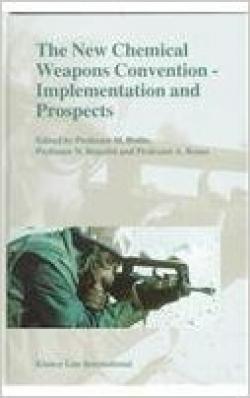The New Chemical Weapons Convention. Implementation and Prospects

The Chemical Weapons Convention entered into force on 29 April 1997, and the major player, namely the United States, ratified it shortly before that date. This constitutes an important achievement in disarmament law and also a step forward in general international law, as the Convention, in order to solve a serious security problem, establishes an unprecedented regime for controlling relevant state and private behaviour, administered by a newly-created international organization. The system being both new and complex, there is a considerable need for interpretation and explanation. In order to make the Chemical Weapons Convention really work, additional measures of implementation are needed. These two problems are addressed by the various contributions presented in this book, which is the result of a common research project of three teams directed by the three editors. It reviews the history of the negotiations and then presents a thorough analysis of the major theatres of the Convention: the organization (OPCW), the verification regime, dispute settlement and reactions to non-compliance. More specific issues include confidentiality, application during armed conflicts, trade issues and national implementation. The information contained in the volume, including the report on the work of the Preparatory Commission, is up-to-date at the time of entry into force.
Result of a research project conducted by the Istituto Affari Internazionali (IAI) in cooperation with the Institute of Public Law, University of Frankfurt, and the Department of Law, Åbo Academy University (Turku).
Preface, p. ix-x
About the authors, p. xi-xii
Abbreviations and Acronyms, p. xiii-xv
Part I. General Issues
1. The Chemical Weapons Convention: A General Overview, Michael Bothe, p. 1-15
2. The Negotiations on the Chemical Weapons Convention: A Historical Overview, Julian Perry Robinson, p. 17-36
3. On-Site Inspections as a Form of Verification in Arms Control Agreements, Raija Hanski, p. 37-57
4. Verification in the `Global Commons': Existing Regimes, Kerstin Stendahl, p. 59-77
5. The Law of IAEA Safeguards: A Framework for the Legal Problems of Chemical Weapons Verification?, Torsten Lohmann, p. 79-118
Part II. The Organization for the Prohibition of Chemical Weapons
6. The Organization for the Prohibition of Chemical Weapons, Andrea de Guttry, p. 119-151
7. The Preparatory Commission for the Organization for the Prohibition of Chemical Weapons, Pietro Gargiulo, p. 153-165
8. The Work of the Preparatory Commission, the Provisional Technical Secretariat and Preparations for Entry Into Force of the Chemical Weapons Convention, Treasa Dunworth, Ronald Sutherland and Thomas Stock, p. 167-184
Part III. Destruction of Chemical Weapons
9. The Destruction of Chemical Weapons and Chemical Weapons Production Facilities, Ronald Sutherland, p. 185-202
10. The problem of Old and Abandoned Chemical Weapons under the Chemical Weapons Convention, Thomas Stock, p. 203-218
Part IV. The Verification System
11. Routine Verification under the Chemical Weapons Convention, Thilo Marauhn, p. 219-247
12. Challenge Inspections and Investigations of Alleged Use, Thomas Kurzidem, p. 249-285
13. Conflict Management and the Chemical Weapons Convention, Thomas Kurzidem, p. 287-331
Part V. Special Problems
14. National Trial Inspections and the Verification System of the Chemical Weapons Convention, Ralf Trapp, p. 333-352
15. Protection of Confidential Information and the Chemical Weapons Convention, Ettore Greco, p. 353-378
16. The Chemical Weapons Convention and Its Application in Time of Armed Conflict, Andrea Gioia, p. 379-413
Part VI. Reactions to Non-Compliance
17. Reactions to Non-Compliance with the Chemical Weapons Convention, Allan Rosas, p. 415-461
Part VII. The Chemical Weapons Convention and International Economic Relations
18. Control by States Parties over Private Extra-Territorial Activities: Issues of Jurisdiction and International Responsibility, Marco Gestri, p. 463-486
19. National Regulations on Export Controls and the Chemical Weapons Convention, Thilo Marauhn, p. 487-531
20. Economic and Technological Development and Trade in Chemicals, Natalino Ronzitti, p. 533-542
Part VIII. Implementation of the Chemical Weapons Convention
21. National Implementation of the Chemical Weapons Convention: Some Legal Considerations, Michael Bothe, p. 543-568
22. Implementing the Chemical Weapons Convention in the EU Context, Thilo Marauhn, p. 569-590
Part IX. Conclusions, Michael Bothe, Natalino Ronzitti, Allan Rosas, p. 591-604
Index, p. 605-613


